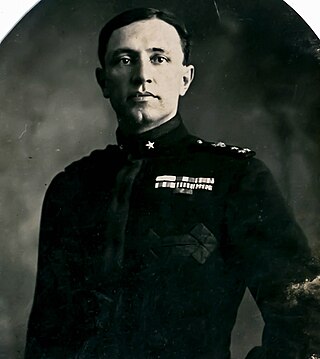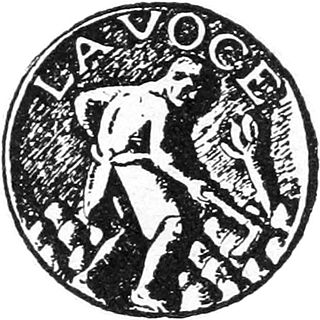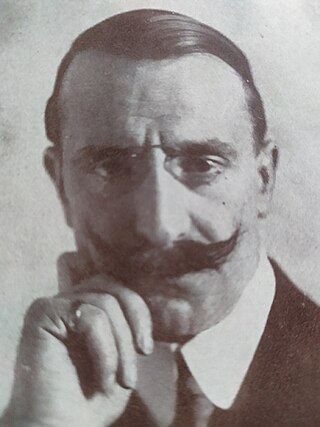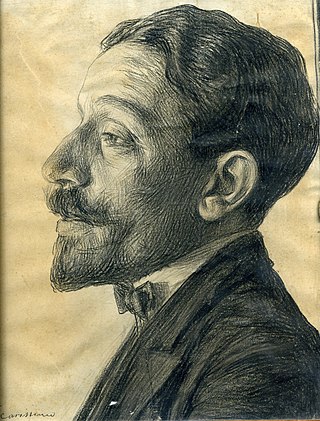Related Research Articles

Grazia Maria Cosima Damiana Deledda, also known in Sardinian language as Gràssia or Gràtzia Deledda, was an Italian writer who received the Nobel Prize for Literature in 1926 "for her idealistically inspired writings which with plastic clarity picture the life on her native island [i.e. Sardinia] and with depth and sympathy deal with human problems in general". She was the first Italian woman to receive the prize, and only the second woman in general after Selma Lagerlöf was awarded hers in 1909.

General Gabriele D'Annunzio, Prince of Montenevoso, sometimes written d'Annunzio as he used to sign himself, was an Italian poet, playwright, orator, journalist, aristocrat, and Royal Italian Army officer during World War I. He occupied a prominent place in Italian literature from 1889 to 1910 and later political life from 1914 to 1924. He was often referred to under the epithets il Vate and il Profeta.

Giovanni Papini was an Italian journalist, essayist, novelist, short story writer, poet, literary critic, and philosopher. A controversial literary figure of the early and mid-twentieth century, he was the earliest and most enthusiastic representative and promoter of Italian pragmatism. Papini was admired for his writing style and engaged in heated polemics. Involved with avant-garde movements such as futurism and post-decadentism, he moved from one political and philosophical position to another, always dissatisfied and uneasy: he converted from anti-clericalism and atheism to Catholicism, and went from convinced interventionism – before 1915 – to an aversion to war. In the 1930s, after moving from individualism to conservatism, he finally became a fascist, while maintaining an aversion to Nazism.

Enrico Corradini was an Italian novelist, essayist, journalist and nationalist political figure.

Giulio Aristide Sartorio was an Italian painter and film director from Rome.
Giuseppe Antonio Borgese was an Italian writer, journalist, literary critic, Germanist, poet, playwright and academic naturalized American.

Massimo Bontempelli was an Italian poet, playwright, novelist and composer. He was influential in developing and promoting the literary style known as magical realism.
Literaturoper, a term coined by the German music critic Edgar Istel, describes a genre of opera that emerged during the late 19th century. When an existing play for the legitimate theatre is set to music without major changes and without the intervention of a librettist, a “Literaturoper” is the result. Although the term is German, it can be applied to any kind of opera, irrespective of style or language.

Romano Romanelli was an Italian artist, writer, and naval officer. He is best known for his sculptures and his medals.

Vittorio Matteo Corcos was an Italian painter, known for his portraits. Many of his genre works depict winsome and finely dressed young men and women, in moments of repose and recreation.

La Voce was an Italian weekly literary magazine which was published in Florence, Italy, between 1908 and 1916. The magazine is also one of the publications which contributed to the cultural basis of the early forms of Fascism. It also contributed to the development of the concept of Europeanism.

Fratelli Treves was an Italian publishing house based in Milan. Founded in 1861 by Emilio Treves from Trieste, it was active under its own name until 1939.
Emilia Errera (1866–1901) was an Italian teacher and writer who specialized in historical and literary essays and critiques, notably about Charles Dickens.
Rosa Errera was an Italian writer, translator, and teacher. Her most well known work, published in 1921, was about the poet Dante Alighieri.
Luisa Giaconi was an Italian poet. Her work represents one of the most significant expressions of Italian symbolism in women's writing, projected towards the new sensibilities of the twentieth-century.

Enrico Thovez was an Italian artist-polymath best known for his contributions as a poet and literary critic.
La Lupa was a weekly magazine which was published in Florence, Italy, in the period 1910–1911. Although it existed for a short period, it is known to be one of the publications which laid the foundations of the fascist governments in the following years.

Ugo Ojetti was an Italian journalist-commentator and author. He wrote prolifically on a wide range of topics. His output also includes short stories and at least seven novels. Nevertheless, during his later decades he increasingly focused on arts criticism, and it is as an art critic that he is most frequently identified in the more generalist sources. Widely admired for his mastery of language, and especially of Italian, he is also commended by admirers as an exceptionally effective aphorist.

Guelfo Civinini was an Italian poet, playwright, novelist, journalist, critic, opera librettist, academic, military combatant, Western explorer, documentary film maker, and archaeologist. Best known internationally as the author of the libretto for Giacomo Puccini's opera La fanciulla del West (1910), Civinini began his career as a writer in the 1890s working as both a journalist and critic of literature and art for a variety of Italian newspapers and magazines. His first book of poetic verses, L'urna, was published in 1901 and was the recipient of a national literary prize. After this he continued to work as a journalist and critic and publish and write poetry, but expanded his interests into writing numerous plays for theaters in Rome and Milan. In 1912 his novel, Gente di palude, was published. He was awarded several literary prizes, including the Mussolini Prize for literature in 1933; the Viareggio Prize in 1937; and the Marzotto Prize in 1953.
References
- 1 2 3 4 5 6 7 8 Silvio Bigliazzi (2020). "1916: Italian narratives of the Tercentenary crisis". In Silvio Bigliazzi (ed.). Shakespeare and Crisis: One hundred years of Italian narratives. Vol. 2. Amsterdam: John Benjamins Publishing Company. p. 34. doi:10.1075/sec.2. ISBN 978-90-272-6111-3. S2CID 241056043.
- 1 2 "Home/riviste/Il Marzocco: periodico settimanale di letteratura e d'arte". National Library. Retrieved 19 October 2021.
- 1 2 "Il Marzocco 1896-1932" (in Italian). Il Libro dei Soci del Gabinetto Vieusseux. Retrieved 18 October 2021.
- 1 2 3 4 5 Laura Scuriatti (July 2017). "Transnational Modernist Encounters in the Provinces: Lacerba, Mina Loy and International Debates on Sexual Morality in Florence". Forum for Modern Language Studies. 53 (3): 303–313. doi:10.1093/fmls/cqx014.
- ↑ Elisa Bizzotto (2010). "'Children of Pleasure': Oscar Wilde and Italian Decadence". In Stefano Evangelista (ed.). The Reception of Oscar Wilde in Europe. London; New York: Continuum. p. 126. ISBN 978-1-4411-7368-3.
- ↑ Giorgia Alù (2021). Literature and Photography in Italy . Oxford Research Encyclopedias. doi:10.1093/acrefore/9780190201098.013.1201.
- ↑ Gabriella Bosano (November 1926). "Current Italian Periodicals". Italica. 3 (4): 83. JSTOR 476108.
- ↑ Joanna Sondel-Cedarmas (2008). "Imperialism, war, and emigration in Enrico Corradini at the ideology of Italian Nationalism (1896-1912)". Politeja. 10 (1): 111. JSTOR 24919295.
- ↑ Emilio Gentile (October 1998). "The Struggle for Modernity: Echoes of the Dreyfus Affair in Italian Political Culture, 1898-1912". Journal of Contemporary History . 33 (4): 501. doi:10.1177/002200949803300402. S2CID 154027605.
- 1 2 3 Corinna del Greco Lobner (1993). "A Giornalista Triestino: James Joyce's Letter to Il Marzocco". Joyce Studies Annual. 4: 184–185. JSTOR 26283691.